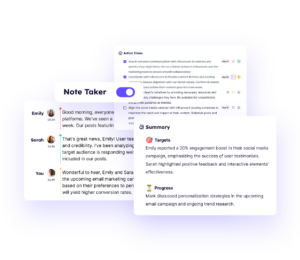Phonetic transcription is essential in improving overall communication. This type of transcription is even more useful now when people share ideas and communicate on a global scale, such as in learning institutions, businesses, and more.
So, what exactly are phonetic transcriptions, and how can they be applied in our everyday lives? This article will discuss all of them.
What is Phonetic Transcription?
To put it simply, phonetic transcription is the conversion of spoken words the way they are pronounced instead of how they are written.
There are usually different types of phonetic transcription, from verbatim to intelligent verbatim transcriptions. Moreover, there are also other more specialized types like academic or legal transcriptions.
You probably know what transcription of words is about — converting an audio or video to text format. This general transcription helps in numerous ways, including accessibility, record-keeping for future reference, etc.
However, phonetic transcriptions play a different role, which we’ll look at shortly.
Unlike regular spelling, which can vary greatly between languages and dialects, phonetic transcription of words provides a universal and systematic approach to capturing the sounds of speech.
The International Phonetic Alphabet (IPA) is the most widely used system for phonetic transcription. It includes symbols for consonants, vowels, and suprasegmental features such as stress and intonation.
Phonetic Transcription Examples
Phonetic transcriptions have symbols that include characters from the Latin alphabet, as well as special characters unique to the IPA. Here are some common categories of phonetic symbols:
- Consonants: Symbols representing the sounds produced by obstructing or constricting airflow in the vocal tract, such as /p/, /t/, /k/, /m/, and /s/.
- Vowels: Symbols representing the sounds produced without significant constriction of airflow, including /i/, /e/, /a/, /o/, and /u/.
- Suprasegmental features: Symbols for indicating stress, intonation, and other features that extend over multiple sounds, such as /ˈstres/ for “stress.”
Now, let’s look at some phonetic transcription examples for English words:
- Cat: /kæt/
In this transcription, the “c” represents the sound /k/, the “a” represents the short vowel sound /æ/, and the “t” represents the sound /t/.
- Fish: /fɪʃ/
Here, the “f” represents /f/, the “i” represents /ɪ/ (a lax vowel), and the “sh” represents the consonant cluster /ʃ/.
- Dog: /dɔg/
In this transcription, the “d” stands for /d/, the “o” represents /ɔ/ (a back vowel), and the “g” represents /g/.
- Telephone: /ˈtɛl.əˌfoʊn/
This transcription includes suprasegmental features, with “ˈ” indicating primary stress on the first syllable and “ˌ” indicating secondary stress on the third syllable.
- Happiness: /ˈhæp.i.nɪs/
In this example, you can see the complex transcription of a multisyllabic word, indicating the various vowel and consonant sounds and stress placement.
When Should You Use Phonetic Transcription?
Phonetic transcriptions offer an excellent way to represent the spoken language in a more standardized manner.
One of its primary uses is in linguistics. However, this type of transcription of words isn’t limited to academia; there are numerous other situations where it can be incredibly beneficial.
Let’s take a look at some of the core uses of phonetic transcriptions in various aspects:
Linguistic Research
Phonetic transcription is indispensable for linguistic research. Linguists use it to analyze the phonological features of languages.

It helps them identify phonemic contrasts, study sound patterns, and uncover the subtle nuances that distinguish one dialect from another.
Language Learning And Teaching
There are two primary ways phonetic transcription of words can be helpful in learning institutions: for learning and teaching purposes.
- To Improve Pronunciation
For language learners, phonetic transcription is a valuable aid in improving pronunciation.
It allows learners to visualize and practice the correct articulation of sounds, helping them speak more fluently and accurately.
- To Teaching Phonetics
Those teaching a particular language often use phonetic transcription to teach phonetics, the study of speech sounds.
Using phonetic transcriptions enables them to explain the articulation of sounds and helps students understand the phonological rules of a language.
Speech Therapy
Speech therapists use phonetic transcription of words to assess and diagnose speech disorders. These professionals use phonetic transcriptions to help them identify the errors their clients make during a speech and will use this analysis to design a customized therapy plan to address the specific issues.

Translation And Interpretation
During a translation or interpretation practice, professionals often prefer using phonetic transcriptions to maintain the fidelity of the original spoken content.
Using this type of transcription helps them to ensure that the translated or interpreted text accurately reflects the pronunciation of the source language.
Language Preservation
It is a no-brainer that, due to globalization, certain languages are slowly becoming extinct or endangered.
Fortunately, linguists and anthropologists use phonetic transcription to document endangered languages and oral traditions.
It plays a crucial role in preserving the linguistic heritage of communities at risk of losing their languages.
Voice Acting
One of the most important aspects of being a voice actor is being able to read and comprehend phonetic transcriptions. By following these transcriptions in their work, voice actors can accurately replicate accents, dialects, and speech patterns.
Business Operations
Many businesses are now embracing phonetic transcriptions in various aspects of their operations.
For instance, some companies integrate their branding efforts with phonetic transcriptions.
Such companies seek to be more inclusive, especially to non-native speakers. This starts right from their brand names, enabling people from diverse backgrounds to pronounce their brand name correctly.
Moreover, some businesses consider using phonetic transcriptions during their sales calls, especially with international speakers. This enables these companies to review their sales pitches and ensure they conform to how their customers understand them better, allowing them to review their sales strategies.
Phonemic vs Phonetic Transcription
We have already discussed that phonetic transcription of words provides a detailed representation of every sound in speech, using specific symbols for each sound. This method captures even subtle nuances such as aspiration or lengthened vowels, making the transcription longer and more complex.
In contrast, phonemic transcription offers a simplified approach called “broad” transcription. Instead of focusing on minute details, it uses fewer symbols to represent sounds perceived as the same by native speakers. For example, similar sounds are represented with the same symbol if they do not affect meaning.
The main distinction between the two lies in their usage of symbols: phonetic transcription encloses symbols in square brackets [ ] to denote the exact pronunciation. In contrast, phonemic transcription of words uses slashes / / to focus on the key sound contrasts.
Phonemic transcription is particularly useful for language learners, as it helps them focus on mastering essential sound patterns without being overwhelmed by intricate pronunciation details.
What Are The Limitations Of The Phonetic Transcription of Words?
Like any system, phonetic transcription has its limitations. As a rule of thumb, it would be prudent for those who want to use this transcription to understand its limitations and avoid inconveniences entirely.
Here are some of the main limitations you can get from using phonetic transcription of words:
Variability in Pronunciation
Pronunciation can vary significantly among individuals, regions, and dialects. While phonetic transcription provides a standardized representation, it may not account for all the subtle variations in pronunciation.
Ambiguity
Phonetic symbols can sometimes be ambiguous, leading to potential misinterpretations. For example, the symbol /r/ represents the rhotic sound, but the pronunciation of /r/ can vary among dialects and accents.
Furthermore, some symbols in the IPA can represent multiple sounds depending on context, making interpretation challenging.
Time Commitment
Transcribing speech using the IPA can be time-consuming, particularly for longer passages or when dealing with languages with complex phonological systems. This limitation can make large-scale transcription projects challenging and resource-intensive.
Difficulty Transcribing Non-Standard Sounds
Phonetic transcription may struggle to represent non-standard or informal speech sounds, such as those found in everyday speech, slang, or rapid speech patterns.
These variations may not have standardized symbols in the IPA, making it difficult to transcribe them accurately.
You Need Specialized Training
Phonetic transcription is a specialized skill, and the symbols used may not be intuitive for individuals not trained in linguistics. This can make transcriptions inaccessible to the general public and limit their usefulness in educational contexts.
Using Phonetic Transcription Tools
Phonetic transcription tools have simplified converting sounds into phonetic symbols, making it easier for transcribers to generate accurate representations of spoken language. These tools range from online converters that allow users to input words or phrases and instantly receive phonetic transcription in IPA symbols to more advanced software that supports large-scale transcription projects.
Many online tools offer free services, enabling users to write phonetic transcription for individual words or sentences. However, they often come with limitations, such as restricted word counts or language support. These are useful for quick transcriptions but aren’t equipped to handle complex projects requiring detailed phonetic transcription of words across different languages or large audio files.
Professional tools are available for larger and more accurate transcriptions. While these typically require a subscription, they provide higher accuracy and functionality. Paid software, for instance, allows users to transcribe audio into phonetic script, supports multiple languages, and offers automated services that speed up the process.
Though these tools don’t fully replace human accuracy, they can provide an efficient starting point, particularly in contexts where phonetic transcription examples are needed quickly, such as content development or business transcription projects. Transcribers can then refine the automated output for precision, ensuring the transcription meets the task’s specific needs, whether for phonetic or phonemic transcription.
Transcriptions Made Easier With Krisp
Krisp has a meeting transcription tool that makes accessing a textual version of your meeting conversations easy. If you want your discussions recorded in text format, Krisp can accurately and smoothly handle that for you.
Krisp uses its AI Meeting Assistant to work in the background during your online or hybrid virtual meetings to get you a transcription of your conversations. Unlike most other tools, it is pretty easy to get meeting transcriptions from Krisp:
- Download the Krisp app and sign up;
- Change the settings of your online meeting app and enable Krisp on your microphone and speaker;
- Join or start your meetings as usual, and Krisp works in the background to transcribe your meetings.

One of the perks of using Krisp is that you don’t need to do any complex setup processes. In fact, you can get a Zoom or Teams meeting without recording.
Additionally, you can use Krisp’s AI meeting note taker to create accurate summaries of your transcript. You can easily take meeting notes without having to divide your attention during the meeting.
Conclusion
Phonetic transcription is an invaluable tool for capturing the precise sounds of spoken language. Its applications extend beyond linguistics into language learning, speech therapy, business operations, and even language preservation.
Using symbols from the International Phonetic Alphabet (IPA), phonetic transcription ensures that pronunciation is accurately represented, regardless of language or dialect. While there are challenges, such as variability in pronunciation and the complexity of IPA symbols, phonetic transcription remains a powerful method for improving communication and understanding in both personal and professional settings.
Frequently Asked Questions


